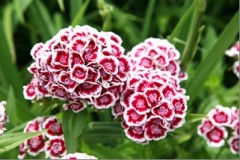Sweet William
| Infobox on Sweet William | |
|---|---|
| Example of Sweet William |  |
| Facts | |
| Origin | - |
| Stowage factor (in m3/t) | - |
| Humidity / moisture | - |
| Ventilation | - |
| Risk factors | See text |
Sweet William
Contents
Description / Shipment / Storage / Risk factors
Scientific Name and Introduction
Dianthus barbatus. A close relative of carnation, normally grown in the field, Sweet William flowers are borne on a short-stemmed inflorescence. Colours range from white through intense red and purple, and provide strong accents in an arrangement. The specific epithet barbatus means bearded or barbed in reference to the beard-like growth emerging from the petals.
Quality Characteristics and Criteria
Flowers in the Sweet William inflorescence continue developing after harvest and they should be harvested with the outer ring of flowers open. Flowers should have at least the outer whorl of florets open. Avoid flowers with withered or sleepy florets, as this indicates ethylene-induced problems.
Grading and Bunching
Quality Sweet William flowers are of uniform maturity, are free from damage and evidence of pests and diseases, have reasonable stem length and good quality foliage. Flowers are sold in a grower's bunch of at least 12 stems.
Ethylene Sensitivity
Flowers are ethylene-sensitive.
Pretreatments
Flowers should be pretreated with 1-MCP or STS to prevent effects of ethylene.
Storage Conditions
Like carnations, flowers should be stored at 2°C to 3ºC.
Packing
Sweet William flowers are normally packed in horizontal fibreboard boxes.
Special Considerations
As with many flowers grown in the field, fungal infections due to the wet foliage and flower conditions sometimes experienced at harvest can be a problem. Make sure flowers are rapidly unpacked and aerated to reduce possible disease spread.
Sources used
BMT Consolidated Manual on (Dutch) Flower Bulbs, cut flowers/greens and potted plants.











